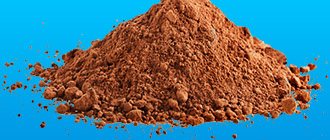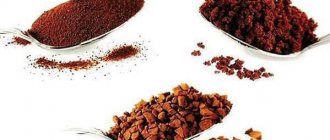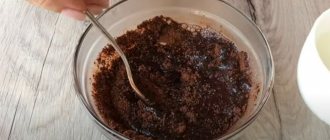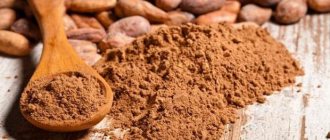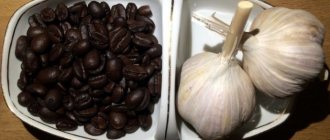Cocoa invigorates, lifts your mood and even smoothes out wrinkles. And delicious desserts and drinks with it diversify the diet menu. Find out the calorie content of cocoa and include dishes with it in your diet without harming your figure!
Author: Kristina Lobanovskaya, doctor, practicing nutritionist Article updated: 11/09/2020
Ask a Question
Cocoa is a general name that refers to both the type of plant and its seeds (beans), as well as the powder and drinks obtained from them. In addition, very healthy and tasty oil is squeezed out of cocoa beans. All these products are widely used in the food industry, mainly for the production of chocolate, sweets and confectionery, as well as in the home preparation of drinks and desserts. At the same time, the calorie content of cocoa per 100 grams varies significantly (from 25 to 899 kcal) depending on the raw materials obtained and the method of further use.
Bobov
Cocoa beans are consumed in their own form, mainly ground to a grain state, and are also industrially processed into other products. By pressing, oil is extracted from them, which serves as the basis for chocolate, and the remaining dry cake is ground into cocoa powder, which has a very wide range of applications. The energy value of whole beans is 565 kcal/100 g, which is the average caloric value of cocoa, since seeds are the raw material for all cocoa products, including the most nutritious oil and low-calorie dietary fiber (cake). Before delivery to the consumer, cocoa beans undergo mandatory fermentation, during which the ability to germinate is eliminated, but all beneficial properties are retained.
Cocoa seeds are almond-shaped and have a dark skin (cocoa shell), which must be removed before use by soaking them in water for several minutes and then cutting lengthwise with a knife. Although if the beans are dry, they peel off easily, like seeds. Their smell is incredible, reminiscent of the strong aroma of chocolate with notes of vanilla, and their taste is slightly bitter, like coffee beans. You can experiment with consumption, but when you first try it, it is advisable to eat 2-3 pieces in their “pristine” form. As a rule, this becomes a real discovery of new tastes and sensations, since an invigorating effect appears almost immediately, which lasts about 2 hours.
To get a more delicate taste and a less pronounced energy burst, it is recommended to take shelled cocoa seeds with honey. But it should be borne in mind that the already fairly high calorie content of cocoa will increase even more by adding a nutritious component such as honey. You can also grind the seeds in a coffee grinder or purchase ready-made cocoa nibs. It is used for sprinkling ice cream, desserts, fruits and dried fruits, making healthy homemade sweets, and adding it to cocktails and coffee. But even in this case, the calorie content of cocoa after purification and crushing also increases - up to 607 kcal/100 g.
Important! When consuming cocoa beans, you must remember that the consumption rate for the raw product is 40–50 g (4−5 tbsp.) per day for a weight of 70 kg. The specified amount should be distributed evenly throughout the day, taking 1 tbsp. l. 1 time and at least 3 hours before bedtime.
The chemical composition of cocoa seeds includes several hundred biologically active substances, the beneficial properties of which are still being studied by scientists today. The most valuable of them are vitamins and minerals, as well as some natural compounds that have a powerful positive effect on the body, promoting overall health and normalization of body weight, despite the increased calorie content of the product.
Studies have shown that even when eating regular chocolate, life expectancy increases on average by 1 year. Therefore, you can imagine how many benefits raw cocoa seeds provide, retaining all their natural properties. However, the main discovery is the results of studies proving that a drink made from fresh cocoa beans has 3 times more antioxidants than green tea. Since the calorie content of cocoa is an order of magnitude higher than the energy value of tea, it makes sense to talk about it as the most healthy, tasty and nutritious product that can completely replace a full-fledged snack.
In addition, the benefits of raw cocoa seeds include the ability to provide the following benefits:
- improvement of the cardiovascular system;
- reducing the risk of stroke, heart attack, diabetes, stomach ulcers and even oncology;
- accelerating the growth of skin cells, which ensures rapid healing of superficial wounds and smoothing of wrinkles;
- increased libido, restoration of sexual functions;
- normalization of the emotional and mental state, the appearance of a feeling of euphoria.
In general, cocoa beans speed up all internal processes and improve the functioning of the entire body. But since, due to the increased calorie content and too pronounced stimulating effect, they are recommended to be consumed in small quantities, then in order to obtain the indicated beneficial effects, such a product should be introduced into the diet every day and for a long time.
The benefits and harms of cocoa with honey
Honey is a healthy product, but only if it has not undergone heat treatment. High temperature leads to the destruction of almost all useful elements contained in this product. You should add honey to the drink only after it becomes warm.
Cocoa with honey, when properly prepared, has a number of healing effects on the body:
- weakens inflammatory processes;
- prevents the development of fungi;
- accelerates tissue regeneration;
- promotes the removal of harmful substances;
- prevents constipation;
- strengthens the immune system;
- increases the elasticity of the heart muscle and blood vessels;
- helps improve the condition of bone tissue;
- prevents the occurrence of acne;
- slows down the aging process;
- prevents the formation of malignant tumors;
- normalizes the functioning of the reproductive system;
- reduces the likelihood of developing vitamin deficiency and anemia;
- has a calming and stabilizing effect on the central nervous system;
- helps get rid of the constant feeling of drowsiness;
- normalizes blood pressure;
- eliminates sleep disorders;
- stimulates appetite;
- has an analgesic effect.
Read: Benefits of Kaushiki
Honey and cocoa often cause an allergic reaction, so these products should be introduced into the diet with caution. A drink based on them should not be consumed during pregnancy and breastfeeding. In addition, the product is contraindicated in the presence of the following diseases:
- diabetes;
- serious disturbances in bowel function;
- caries;
- obesity;
- individual intolerance.
Powder
Cocoa powder, as a result of processing cocoa beans from which butter is extracted, has a lower calorie content compared to the original raw material - it contains from 235 to 374 kcal per 100 grams. This indicator varies depending on the residual amount of fat in the resulting powder. In accordance with this feature, there are 3 categories of such a product:
- low-fat (less than 14% fat) - 235 kcal/100 g, 58.8 kcal/1 tbsp. l., 21.4 kcal/1 tsp;
- bold (up to 20%) - 297 kcal/100 g, 74 kcal/1 tbsp. l., 27 kcal/1 tsp;
- fatty (more than 20%) - 374 kcal/100 g, 34 kcal/1 tsp, 93.5 kcal/1 tbsp. l.
Important! It should be borne in mind that even low-fat cocoa powder, the calorie content of which is considered the minimum of all categories of this product, remains highly nutritious and requires moderate consumption. The very conditional low calorie content should not become a reason for the abuse of drinks based on it.
The energy value of one cup of hot cocoa prepared according to the classic recipe is 250 kcal. This is due to the addition of sugar, 1 teaspoon of which contains 20 kcal, as well as milk, which is also a very nutritious component (depending on the fat content). Thus, by drinking a serving of this drink 3 times a day, you can exhaust half of the total calorie content of your daily diet. On the other hand, it is quite nutritious and quickly causes a feeling of satiety, so you won’t be able to drink in large quantities. The ideal option is 1 glass of drink during breakfast to get a boost of energy and lift your spirits, as well as another cup as a healthy snack.
When choosing cocoa powder, it is necessary to take into account that they differ not only in the degree of fat content, but also in the production method - there is natural and alkalized. In the first case, dry raw materials are not processed in any way, and in the second, an alkaline solution is used for processing. It is completely harmless, prepared from ordinary soda and helps to extract volatile fatty acids and a significant amount of tannins from the resulting product. Thanks to this, alkalized cocoa powder has a darker color, exquisite taste, rich aroma and reduced calorie content.
The beneficial properties of cocoa powder are manifested in the fact that under the influence of its active components a number of positive changes occur in the body:
- the production of the “hormone of joy” endorphin increases, which helps improve the emotional and mental background and prevents the development of depression, including that associated with limited nutrition during strict diets;
- the skin becomes healthier, more elastic and protected from the harmful effects of ultraviolet rays and other external factors;
- blood pressure is normalized, the walls of blood vessels are strengthened, the risk of strokes and heart attacks is reduced;
- blood circulation is activated, the likelihood of heart disease is reduced;
- muscles relax, which is useful for athletes after competitions or intense training, as well as for people engaged in heavy physical labor;
- prevention of diabetes, stomach ulcers and cancer is being created.
Despite the relatively high energy value, cocoa drinks or powder-based desserts are an excellent healthy substitute for sweets for those who are trying to lose weight or control their weight by counting calories. In any case, the calorie content of cocoa prepared at home is significantly lower than that of store-bought sweets and confectionery. In addition, cocoa powder is extremely easy to use and can be added to a wide variety of recipes, giving dishes the taste and aroma of chocolate.
To purchase a truly useful product, you should choose factory packaging that guarantees proven quality of the product and prevents the ingress of harmful microorganisms. If you shake the pack well, you can determine by the sound whether the mass inside is loose and whether it has clumped into a lump, which happens when stored in conditions of high humidity. You also need to check the expiration date, which is limited to 12 months.
Calorie content of cocoa without sugar per 100 grams
Calorie content of cocoa without sugar per 100 grams is 56 kcal. A 100 gram serving contains:
- 3.5 g protein;
- 2.2 g fat;
- 5.6 g carbohydrates.
Read: Calorie content of sweet red apple
Recipe:
- 0.5 liters of 1.5 percent milk is brought to a boil;
- add 20 g of cocoa powder to milk;
- the drink is boiled and infused for 3 minutes;
- Cocoa should be served warm.
Oils
Cocoa butter has the highest calorie content among all products made from cocoa beans - 899 kcal/100 g. At its core, it is a vegetable fat, which is obtained by pressing from seeds. The finished product has a creamy milky or yellow color and emits a sweet chocolate aroma at room temperature. At an ambient temperature of 18ºC, cocoa butter becomes hard and breaks easily, at 35ºC it begins to melt, and after 40ºC it becomes completely transparent.
Currently, 2 types of edible cocoa butter are produced - natural and deodorized. The first is distinguished by its useful vitamin and mineral composition, high consumer characteristics and excellent taste. The second undergoes additional processing, during which a significant part of the valuable substances is lost and the taste and aromatic qualities are reduced.
The beneficial properties of natural cocoa butter are as follows:
- has a powerful wound-healing effect, similar in strength to badger fat;
- neutralizes the negative effects of free radicals, preventing premature aging;
- maintains the amount of magnesium and potassium at the required level, ensuring proper functioning of the cardiovascular system;
- fights the development of tumor diseases, strengthens the body’s own defenses;
- improves blood supply to the brain, increasing memory and intellectual abilities;
- reduces the amount of “bad” cholesterol, reducing the likelihood of cholesterol plaques appearing on the walls of blood vessels;
- has an antiseptic effect, helps eliminate inflammation;
- helps relieve and reduce the frequency of recurrences of coughing attacks;
- activates collagen synthesis, normalizes skin condition, eliminates rashes and dryness, prevents the appearance of facial wrinkles.
Due to its too high calorie content, cocoa butter is not recommended for consumption if you have obesity, diabetes mellitus and some other diseases. But in minimal quantities, such a product can be taken during the period of weight loss to replenish the deficiency of healthy fats necessary for the body.
The benefits of unsweetened cocoa for the body
Regular consumption of unsweetened cocoa allows you to:
- improve memory and brain performance;
- prevent the development of atherosclerosis, cleanse blood vessels of harmful cholesterol;
- normalize blood pressure, reduce the likelihood of developing thrombosis, stroke, heart attack;
- maintain the functionality of the heart and circulatory system;
- slow down the processes of cellular aging;
- improve physical condition in type 2 diabetes, increase insulin intake;
- reduce the likelihood of developing senile dementia;
- normalize emotional state, reduce the likelihood of depression.
The unsweetened drink is recommended for older people to maintain brain function and prevent the development of Alzheimer's disease. Cocoa beans contain phenylethylamine, a plant hormone that protects brain cells from age-related degenerative processes. As a result, brain aging slows down.
Nutritionists allow diabetics to consume cocoa exclusively without sugar. The product is not only safe for disorders of carbohydrate metabolism, but also brings great benefits to the body.
It contains compounds that increase the body's sensitivity to insulin, due to which the concentration of glucose in the blood decreases. As a result, a diabetic decreases the likelihood of inflammation and destruction of vascular walls, and the accumulation of atherosclerotic plaques.
Dishes
There are a lot of different recipes for using cocoa in cooking. Traditional cocoa, hot chocolate, chocolate coffee and other drinks are brewed from powder and grains, and are also added to various desserts and baked goods. Oil is an integral component of chocolate and the filling of many chocolates and confectionery products. It is cocoa butter, along with sugar, that significantly increases the calorie content of such products, while powder has a slight effect on this indicator. On the other hand, cocoa powder also has a relatively high, but more “healthy” calorie content, since it is formed mainly from proteins and complex carbohydrates. Therefore, if this point is important, in particular when following a low-calorie diet for weight loss or a diet with calorie counting, then you should choose suitable recipes.
Drinks
The most common, simple and affordable use of cocoa is making drinks. Most often they are drunk hot with the addition of milk and sugar, which makes the product an ideal winter drink with a warming effect and beneficial immunostimulating properties. There are several main types of recipes, which differ slightly in the method of preparation and composition, but due to changes in the ratio of components, they allow you to obtain drinks with different tastes and calorie content. Among them are classic cocoa with water or milk, hot chocolate and chocolate-coffee drink. At the same time, chocolate has the highest energy value, and cocoa with water without sugar has the lowest calorie value.
On the water
The nutritional value of the finished water drink depends not only on the properties of the powder, but also on the presence of additional components. So, when preparing cocoa with sugar, the calorie content of the product in this case will be 40 kcal/100 g or 100 calories in one mug, and without sugar - 25 and 70 calories, respectively.
To prepare an unsweetened healthy drink, dilute 20–25 g of cocoa powder in 500 ml of water, pouring it in a thin stream and stirring constantly. Place the resulting mixture on the fire, stirring, bring to a boil and turn off the heat.
Sweet cocoa is prepared in a similar way, but before diluting with water, it is first mixed with granulated sugar. In the classic recipe, it is recommended to use both ingredients in equal quantities. However, you can reduce or increase this ratio, without forgetting that the calorie content of cocoa will change in direct proportion to the addition of sugar.
Since cocoa powder has a very rich taste and aroma, even when cooked in water without adding any other components, a very tasty and healthy dietary product is obtained. Moreover, the calorie content of cocoa in this case becomes negative, that is, fewer calories are supplied than are used for digestion.
With milk
Cocoa with milk is cooked in the same way as with water, but has a slightly increased calorie content. If you take 20 g of cocoa without added sugar for 500 ml of milk with a fat content of 1.5%, then the energy value of the resulting drink will be 56.7 calories per 100 grams, and a significant part of this energy will be obtained from proteins.
The calorie content of cocoa with milk and sugar will have a completely different indicator and structure according to BJU. If you take 1 tbsp. l. cocoa powder and granulated sugar per glass of milk, then the resulting portion will contain 321 calories or 128.4 kcal/100 g. Moreover, there is a high risk that these calories will be deposited in fat reserves, since they mainly consist of simple carbohydrates.
Thus, in order to increase the beneficial properties and reduce the calorie content of cocoa, you need to brew a drink from natural cocoa nibs or alkalized powder in water or milk with 1% fat content, if necessary, with the addition of a sweetener. A cup of this drink will contain only 70 kcal.
With marshmallows
One of the most popular modern ways to consume cocoa is to add a special type of chewing marshmallow - marshmallow - to the drink. The result is not just a hot drink, but a whole dessert with an original taste and a very high calorie content.
The basis of this dish is cocoa prepared in any of the above ways, but the best option is with milk. You don't need to add granulated sugar, since marshmallows are quite sweet on their own. Before drinking, put marshmallows into a cup with the finished drink, which will melt a little in the hot liquid and give it a special consistency and taste, and also increase the calorie content of cocoa to 180 kcal per 100 grams and 451.4 kcal per cup. At the same time, we should not forget that marshmallow also has some beneficial properties, primarily as a source of animal protein (due to its gelatin content).
hot chocolate
Hot chocolate is a very tasty, healthy and extremely nutritious dessert. All components of this recipe have a very high energy value, and the calorie content of cocoa is the lowest of them.
To prepare chocolate in a Turk or small saucepan, mix 2 tbsp. l. cocoa and 1 tsp. corn starch with sugar to taste. Pour in 1 tbsp. l. cooled boiled water, stir until smooth. In a separate bowl, heat 300 ml of cream without boiling and pour into the chocolate mixture in a thin stream, stirring continuously. Heat over low heat or in a water bath, without letting it boil. Remove from heat, leave for 5 minutes to infuse and consume hot.
To calculate the total calorie content of the finished dessert, it should be taken into account that 10% fat cream contains 119 kcal/100 g, 20% – 209 kcal/100 g, 35% – 337 kcal/100 g. The calorie content of sugar is 387 kcal/100 g, and corn starch - 343 kcal in 100 grams and 62.5 kcal in 1 teaspoon. Thus, a cup of hot chocolate can contain from 460 to 1150 calories, depending on the fat content of the cream and the amount of granulated sugar used.
Desserts
In addition to healthy drinks, which are consumed mainly hot, original cold desserts are prepared from cocoa and powder or butter from it is added to baked goods. The most popular are chocolate ones: jellies, homemade sweets and instant cupcakes. When choosing a recipe, it is necessary to take into account that the relatively low calorie content of cocoa practically does not affect the energy value of the entire dish, especially since this component is introduced in very limited quantities. If this indicator matters, then it is better to pay attention to higher calorie ingredients that are used in large volumes. For example, you can choose low-fat dairy products, reduce the amount of granulated sugar, or use natural substitutes instead.
Sour cream jelly
To prepare an original and healthy jelly dessert, first soak 20 g of gelatin in 150 ml of cold water and leave for 15 minutes to swell. At this time, mix 1 liter of sour cream 25% fat with ½ cup of powdered sugar, beat with a whisk until smooth. Heat the gelatin solution slightly in the microwave or over very low heat, bring until completely dissolved, then pour into the sour cream in a thin stream and stir. The resulting mixture is divided in half, 3 tbsp is added to one part. l. cocoa, stir. Pour into cups or transparent bowls, alternating layers - each new layer is laid out after the previous one has hardened. The more layers, the more original the dessert will be. If you lack time, you can make the simplest, two-layer jelly. Before serving, sprinkle the dish with grated chocolate.
When using these components to prepare jelly with cocoa, the calorie content of the finished product will be 237.9 kcal/100 g. If you take sour cream with a fat content of not 25%, but 10%, then this figure can be reduced to 178 kcal/100 g. The calorie content will be even lower a similar dish in which 1% fat milk is used instead of sour cream, and a sweetener is used instead of powdered sugar. 100 grams of this dessert contains only 88 calories.
Chocolate cupcake
The proposed recipe allows you to literally prepare a very tasty, juicy and aromatic, but at the same time healthy dietary cocoa cake with a calorie content of 127.2 kcal/100 g in just a few minutes. To do this, mix 50 g of peeled flour, 15 g of dry protein, 1 tbsp. l. cocoa powder and a pinch of coconut. Beat 1 egg into 160 ml (2/3 cup) of kefir and stir thoroughly with a fork. Cut 1 pear into small pieces. Combine all components and place in a mold or large cup. Bake in the microwave at full power for 5 minutes. Consume chilled.
Homemade sweets
Melt 100 g of coconut manna, add 20 g (1 tbsp) cocoa powder, stir thoroughly. Add 30 g of blueberries or other similar berries. Mix again. Place in small silicone molds, sprinkle with coconut flakes, and place in the refrigerator to cool (at least 20 minutes).
It makes a great alternative to store-bought sweets for healthy snacking. Despite the rather high calorie content - 282.7 kcal/100 g - healthy homemade sweets with cocoa are recommended to be included in a lean, vegetarian, dietary and diabetic diet.
If you don’t have the time or desire to prepare these desserts yourself, you can purchase ready-made candies and chocolate, the production of which uses powder and/or natural cocoa butter. In this case, it is necessary to give preference to quality products from trusted manufacturers who use natural raw materials. Such confectionery products include:
- candies “Babaevskie with hazelnuts and cocoa” - calorie content 537 kcal/100 g and 72 kcal per 1 piece;
- “Toffee Cream cocoa” candies - calorie content 510 kcal/100 g and 42.3 kcal per 1 piece;
- chocolate “Elite bitter” 75% cocoa - calorie content 545 kcal/100 g.
In addition, to simplify the process of preparing the drink, you can purchase a ready-made mixture, which is simply poured with hot or cold water or the same milk. The classic and most common product in this category is Nesquik instant chocolate drink. The calorie content of cocoa prepared according to the manufacturer's recommendations on the packaging is 255 calories in one mug. At the same time, the energy value of dry raw materials is 379 kcal per 100 g, 95 kcal per 1 tbsp. l. and 34 kcal in 1 tsp.
The composition of this product is enriched with a vitamin-mineral complex and, in addition to cocoa powder, contains sugar, maltodextrin, salt, vanilla, cinnamon and soy lecithin. It should be borne in mind that such a minor advantage as quick cooking cannot be compared with the beneficial properties that natural cocoa beans have. Therefore, when used systematically, it is better to give preference to regular powder, and use instant powder only in rare cases.
Calorie content of cocoa with milk and sugar per 100 grams
Calorie content of cocoa with milk and sugar per 100 grams is 102 kcal. In a 100 gram serving of the drink:
- 3 g protein;
- 3 g fat;
- 17 g carbohydrates.
Read: Calorie content of boiled new potatoes
The drink is enriched with vitamins A, B1, B2, B4, B5, B6, B9, B12, C, E, H, PP, minerals magnesium, calcium, sodium, potassium, chlorine, phosphorus, iodine, cobalt, iron, copper, molybdenum , manganese, fluorine, selenium, zinc, chromium.
Stages of preparing cocoa with milk and sugar:
- Brew 20 g of cocoa powder with 200 g of boiling water;
- leave the drink for 3 minutes;
- add 20 g of sugar and 100 g of milk to cocoa.
The nutritional value
Cocoa contains antioxidants, vitamins, and essential minerals. The chemical composition of beans is a real wealth, the basis of which is the most useful and even unique components, including:
- epicatechin - when regularly released into the blood, reduces the incidence of the most common diseases of our time by 10% - stroke, heart attack, diabetes and cancer;
- cocohil - promotes the restoration and development of damaged cells;
- adrenaline - provides additional blood flow to the muscles and brain, increasing muscle tone, mental abilities and speed of reaction;
- arginine - dilates blood vessels, improves heart function, regulates blood pressure, increases libido and concentration of sexual energy;
- tryptophan - improves mood, helps fight eating disorders (anorexia, bulimia, obesity), alcohol and nicotine addiction;
- theobromine and caffeine - produce a stimulating and exciting effect;
- fiber – cleanses and improves intestinal motility, provides quick and long-lasting satiety.
Important! Only organic cocoa beans fully possess all of these beneficial properties. A significant part of the valuable substances remains in non-deodorized oil and natural powder. If chemical components, flavor and aroma enhancers are added to any of these products, then their benefits are practically lost.
Proteins fats carbohydrates
The ratio of BJU, as well as the calorie content or composition of nutrients, varies significantly depending on the type of raw material.
Beans contain:
- proteins – 12.8 g;
- fat – 53.2 g;
- carbohydrates – 9.4 g.
In powder:
- proteins – 24.3 g;
- fat – 15 g;
- carbohydrates – 10.2 g.
In fat-free powder:
- proteins – 22 g;
- fat – 11 g;
- carbohydrates – 12 g.
In oil:
- proteins – 0 g;
- fat - 99.9 g;
- carbohydrates – 0 g.
Thus, from cocoa beans, by separation, both a high-quality protein product - powder, and almost pure vegetable fat - cocoa butter are obtained. In both cases, the calorie content can be called healthy, since it contains no empty calories and contains few carbohydrates, which are also complex.
Macro- and microelements
The mineral composition of cocoa includes a lot of valuable elements that have a variety of beneficial effects on human health:
- molybdenum – regulates oxidative processes, promotes the absorption of vitamin C, activates the synthesis of amino acids in the body;
- fluoride - ensures healthy bones, teeth, hair, is directly involved in hematopoiesis, alleviates the symptoms of osteoporosis, accelerates the absorption of iron;
- manganese - helps normal development of bone tissue, strengthens the immune system, helps normalize digestion, insulin and lipid metabolism;
- copper - activates the construction of proteins and enzymes, participates in cell development processes, normalizes hematopoiesis, promotes the conversion of iron into hemoglobin;
- zinc - helps the proper formation of bones, increases visual acuity and memory, relieves increased fatigue;
- iron acts as a catalyst for oxygen metabolism, increases hemoglobin levels, relieves headaches and irritability, and participates in respiratory processes;
- sulfur - slows down aging, eliminates inflammation, protects against adverse environmental factors, strengthens local immunity;
- chlorine - actively participates in the digestive processes, stimulates the secretion of gastric juice, normalizes its acidity, prevents dehydration of the body, helps remove carbon dioxide, waste and toxins from cells and tissues, promotes the normal production of red blood cells;
- phosphorus - normalizes normal growth, strength and absence of deformation of bones and teeth, participates in almost all biochemical reactions;
- potassium - is responsible for the normal functioning of the cardiovascular system, brain, kidneys, liver, muscle tissue and endocrine glands, stops the development of atherosclerosis, relaxes muscles and relieves muscle spasms, removes harmful substances;
- sodium - have a powerful effect on all cells and intercellular fluid;
- magnesium – controls the health and functioning of the heart, prevents the development of arrhythmia, normalizes heart rhythm, and participates in the vital processes of the whole organism;
- calcium - maintains a healthy musculoskeletal system, teeth and nervous system, prevents the development of multiple sclerosis, osteoporosis, osteomalacia or adult rickets.
All of these elements are present in cocoa in an easily digestible form, and therefore have a more pronounced effect than taking mineral preparations. In addition, even with increased consumption of this product, an overdose is impossible, since the body itself regulates the content and removes the excess.
Vitamins
The presence and variety of vitamins in cocoa is in no way inferior to the mineral components of the composition. Among the most useful are:
- E is considered the main vitamin of youth, actively resists premature aging, protects cells from negative external influences, ensures the normal functioning of the nervous system and the female genital area;
- PP - actively participates in oxidative, respiratory and many other internal processes, has a beneficial effect on the blood vessels of the brain, and participates in metabolism;
- B9 - directly affects the development of the body, ensures the health of the immune, circulatory and nervous systems, participates in digestive processes, is responsible for the production of the hormones serotonin and norepinephrine, directly affecting the psyche and mental activity;
- B6 - improves the processes of breakdown of lipids, proteins and sugars, ensures timely supply of energy, accelerates reaction speed, eliminates insomnia, accelerates the process of natural synthesis of magnesium;
- B5 - takes part in all internal processes, especially in oxidative reactions and acetylation, prevents the development of cardiovascular diseases, colitis and allergies, improves brain function;
- B2 - directly involved in the production of hormones, the formation of red blood cells, the breakdown of basic macronutrients, and promotes constant cell renewal;
- B1 - participates in the conduction of nervous excitation between neurons and cells, protects cell membranes from the harmful effects of peroxide decomposition products;
- A - has a powerful antioxidant effect, participates in redox reactions, regulates protein synthesis, normal metabolism and the functioning of cell membranes, is responsible for the health of eyes, bones, hair and skin;
- beta-carotene - improves immunity, protects against radicals, relieves skin problems, increases visual acuity.
The general effect of the vitamin complex contained in cocoa, with regular consumption of products from it, has a strong positive effect on well-being, activity and appearance. At the same time, you should not get too carried away with the chocolate taste, optimal calorie content and mass of beneficial properties of such a dessert. Cocoa can cause allergic reactions and, in addition, is contraindicated in some cases - with high blood pressure, a tendency to nervous disorders and diseases of the central nervous system. The recommended daily intake of the drink is 2 cups per day. With such consumption, the product will really be useful and will help solve or prevent some health problems.
The benefits and harms of cocoa in water without sugar
A milk drink creates an increased load on the pancreas, sometimes causes an allergic reaction, and is also contraindicated in case of kidney stones and liver diseases. Cocoa in water, in turn, does not have these contraindications and does not overload the gastrointestinal tract.
With moderate consumption of cocoa in water without added sugar, the health effects are as follows:
- prevents the formation of cholesterol plaques;
- stimulates blood circulation;
- improves mood;
- slows down the development of cancer cells;
- prevents the development of hypertension;
- helps strengthen memory;
- reduces brain wear;
- prevents the occurrence of depression, melancholy and apathy;
- has a beneficial effect on the condition of the skin;
- normalizes intestinal function, preventing constipation and diarrhea;
- helps get rid of nausea;
- prevents headaches caused by severe stress;
- prevents the formation and compaction of plaque on teeth;
- accelerates cell regeneration;
- neutralizes the negative effects of sunlight;
- increases the elasticity of blood vessels;
- prevents the formation of wrinkles;
- stabilizes heart rate;
- increases sexual desire.
Read: Benefits and harms of lemon peel
Cocoa may have a beneficial effect on performance and concentration. It is recommended to be included in the diet of people whose work involves severe mental stress, as well as children.
Due to the absence of sugar and low calorie content, the drink normalizes metabolism and promotes weight loss. Cocoa in water is often included in diets. However, excessive use of the product can lead to deterioration of bone tissue. For this reason, cocoa should be introduced into children's diets with caution.
